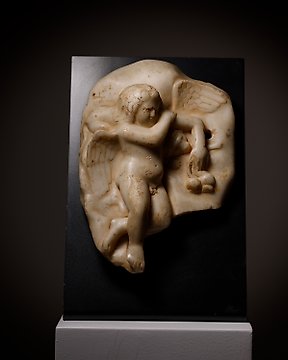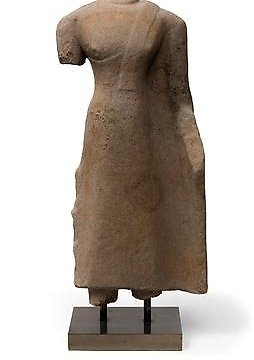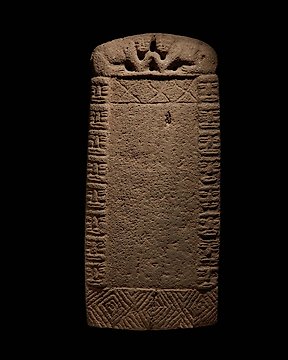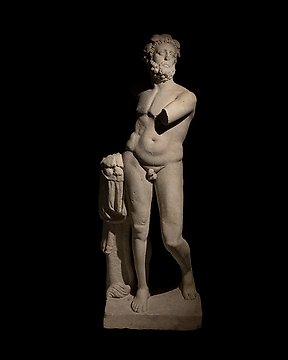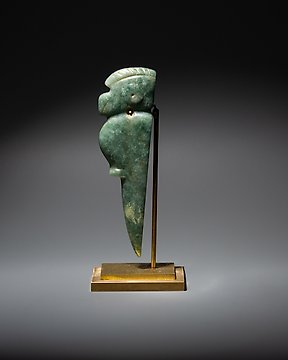All OK and with very fast shipping.
查看翻译古罗马 马赛克碎片,上面有两个戏剧面具的图像。公元 2 至 3 世纪。宽度 100 厘米。
编号 84861119
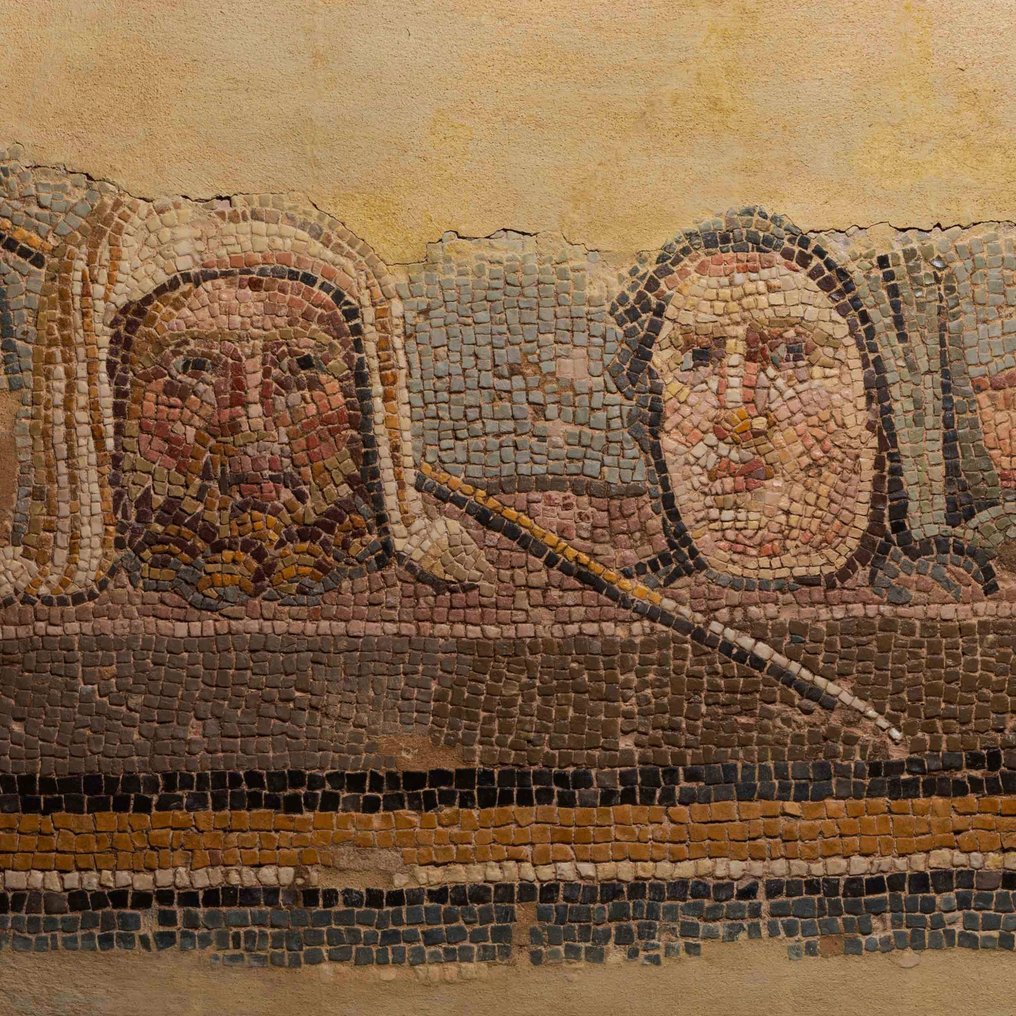
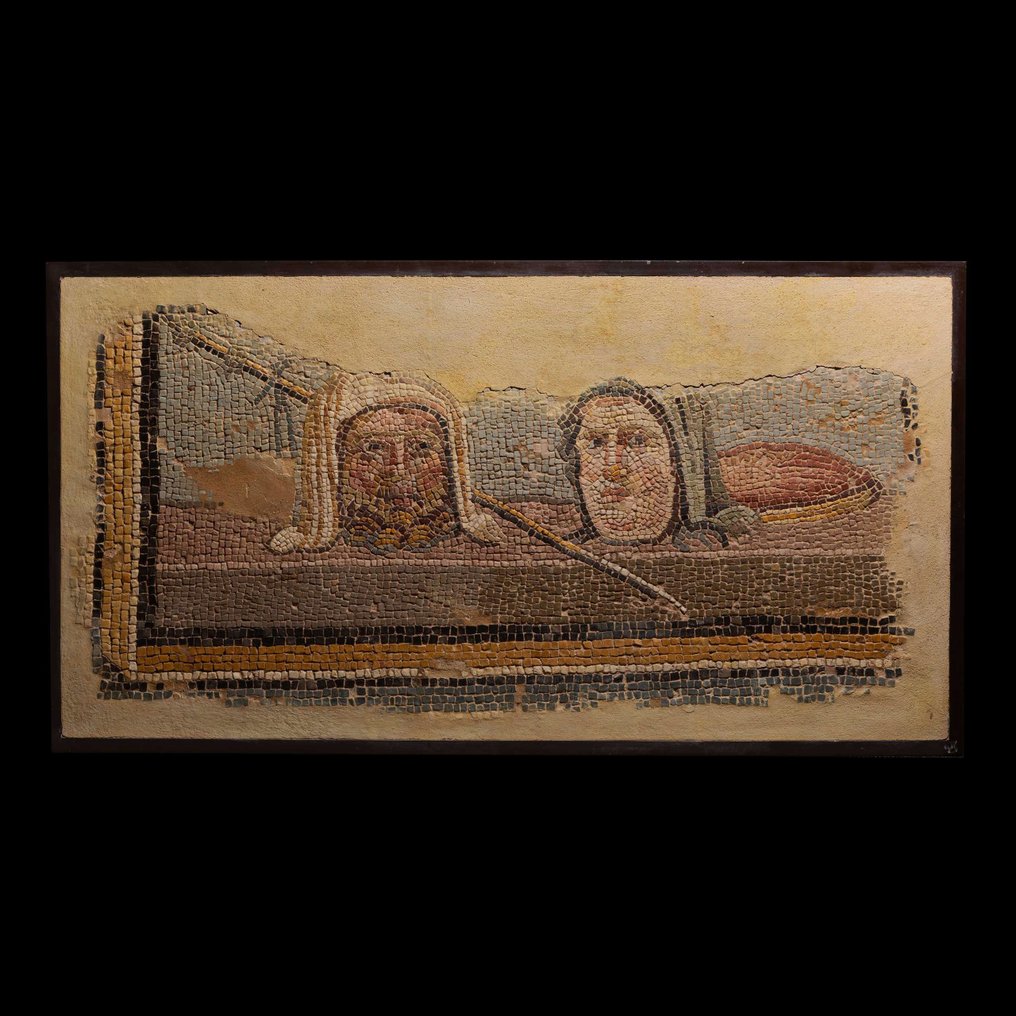
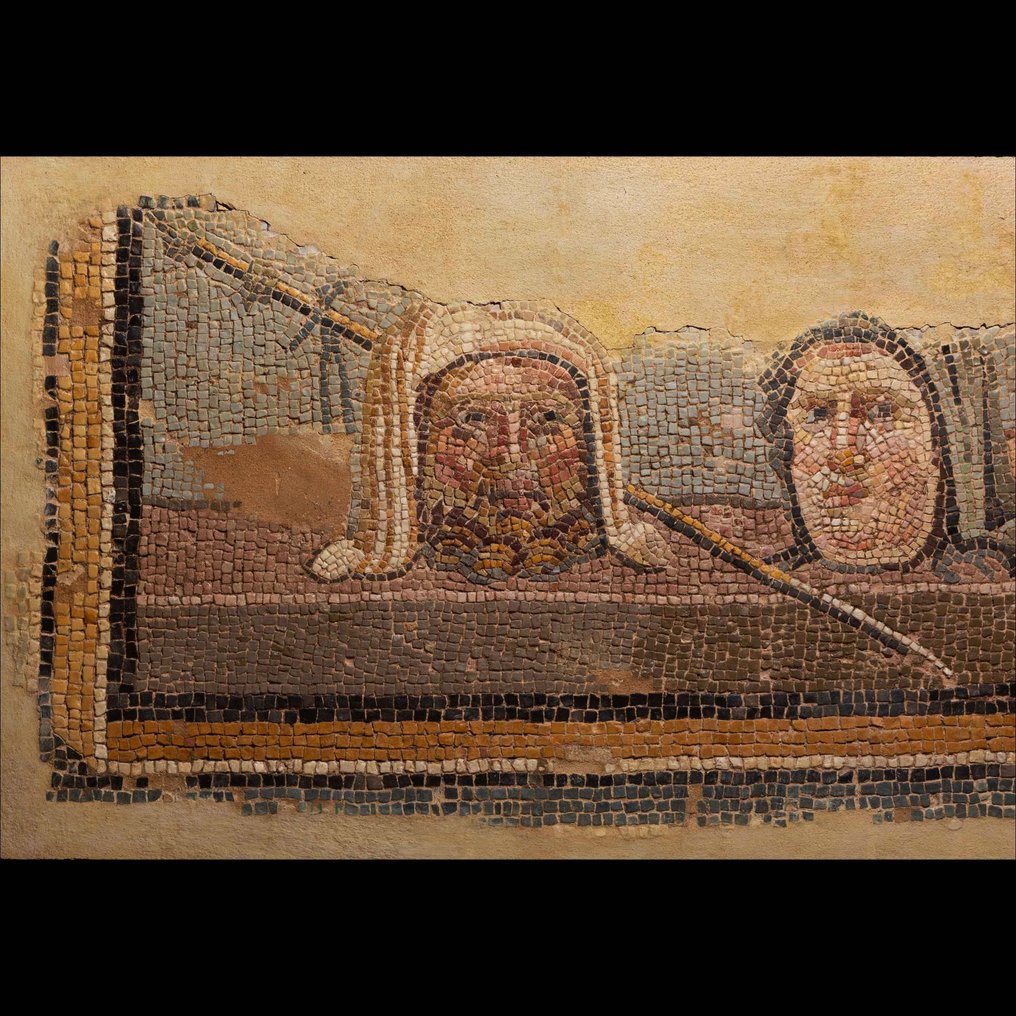
Fragment of a Mosaic with the Image of two Theatrical Masks.
Roman Empire, 2nd - 3rd century AD.
MATERIAL: Marble tiles.
SIZE: Width 100 cm, height 47 cm. Frame: width 110 cm, height 59 cm.
PROVENANCE:
- Private collection, Malibu, California, USA, acquired before 1980.
- New York art market until 2023.
CONDITION: Good condition, mounting on modern support.
BIBLIOGRAPHY:
- DUNBABIN, K. Mosaics of the Greek and Roman world. Cambridge University Press. 1999.
- ÖNAL, M. Zeugma Mosaics. A Turizm Yayinlari. 2009.
PARALLELS:
Fig. 1 Mosaic with female figure, House of the Boat of Psyches. Antioch of the Orontes, Turkey, h. 200-225 AD, opus tessellatum. Musée du Louvre, Paris, inv. MND 1951, MA 3460.
Fig. 2 Mosaic with theatrical mask, House of the Faun. Pompeii, s. II BC, opus vermiculatum. Archaeological Museum Nazionale di Napoli (Italy), inv. 9994.
DESCRIPTION:
Fragment of Roman mosaic made following the opus tessellatum technique, with cubic marble tesserae that cover a wide chromatic range, allowing the flat areas of color to be combined with the light modeling of the faces, based on tonal gradations. This search for three-dimensionality in figurative motifs is typical of the Roman imperial mosaic (fig. 1), unlike the more symbolic and two-dimensional representation of the Byzantine period, where illusionistic modeling was preferably reserved for secondary plant, animal or architectural elements. .
The main motif is two theatrical masks, one male and one female, represented facing the viewer on a floor plane, accompanied by a staff decorated with ribbons and an oval object, perhaps a cushion or an inverted container. This design is framed by bands of flat color in black, white and ocher tones. In the central representation the palette is expanded, using different shades of white, red, yellow and brown to model the faces of the masks and other details, seeking a certain three-dimensional effect.
Theater masks are a common ornamental element in Rome, generally in relation to the Dionysian world and the values associated with it, ideas of a happy, pleasant, beautiful and joyful existence. They were therefore favorable elements for decorating the private sphere, which is why they will be found mainly in the gardens of Roman houses and villas as ornamental elements related to the celebration of life.
Usually, the representation of the theatrical mask in mosaic or fresco painting reproduces the real object used on stage, with the mouth open so that the actor's voice is projected (fig. 2). In this case, however, these are symbolic representations that do not seem to reproduce specific models of canonical theater characters, but directly the archetypes that they represent. The male mask is bearded, with a serene expression, and possibly represents the paterfamilias , the leader of the family and the house. At his side, the female character with a stern face and frown would represent his wife, the matron responsible for the proper functioning and harmony of the home.
The art of mosaic comes to Rome from Greece, and will soon constitute an entire industry, reaching levels of quality never seen before. Its diffusion was such that it became the main form of ornamentation of any Roman villa or house. In Rome, mosaics were built from small pieces called tesserae (hence the name opus tessellatum ), cubic-shaped pieces of calcareous rocks, glass or ceramic, of different sizes. These tiles were arranged on the surface to be decorated like a puzzle, distributing the color and shape according to the design, and were fixed with cement. A second technique, called opus vermiculatum , used tiles of different shapes, which adapt to the design.
At first, when the art of mosaic began to develop in Rome, it was used mainly to decorate ceilings or walls and rarely the floors, because it was feared that it would not offer sufficient resistance to footsteps. Once the technique was perfected, however, the necessary solidity was achieved to be able to apply it to floors, which favored the spread throughout the Empire of its use for the production of luxury flooring.
The growing importance of the mosaic industry is reflected in imperial regulations such as those carried out by Diocletian in the 3rd century, which established very precise price ranges, or by the facilities granted by Constantine to the Mosaists when he moved the capital of the Empire to Byzantium in the year 330, facilitating the exodus of Greek and Roman masters to the new capital and thus laying the foundations of the famous Byzantine mosaic.
Notes:
- The piece includes authenticity certificate.
- The piece includes Spanish Export License (Passport for European Union) - If the piece is destined outside the European Union a substitution of the export permit should be requested, can take between 1-2 weeks maximum.
- The seller guarantees that he acquired this piece according to all national and international laws related to the ownership of cultural property. Provenance statement seen by Catawiki.
#ExclusiveCabinetofCuriosities
卖家故事
Fragment of a Mosaic with the Image of two Theatrical Masks.
Roman Empire, 2nd - 3rd century AD.
MATERIAL: Marble tiles.
SIZE: Width 100 cm, height 47 cm. Frame: width 110 cm, height 59 cm.
PROVENANCE:
- Private collection, Malibu, California, USA, acquired before 1980.
- New York art market until 2023.
CONDITION: Good condition, mounting on modern support.
BIBLIOGRAPHY:
- DUNBABIN, K. Mosaics of the Greek and Roman world. Cambridge University Press. 1999.
- ÖNAL, M. Zeugma Mosaics. A Turizm Yayinlari. 2009.
PARALLELS:
Fig. 1 Mosaic with female figure, House of the Boat of Psyches. Antioch of the Orontes, Turkey, h. 200-225 AD, opus tessellatum. Musée du Louvre, Paris, inv. MND 1951, MA 3460.
Fig. 2 Mosaic with theatrical mask, House of the Faun. Pompeii, s. II BC, opus vermiculatum. Archaeological Museum Nazionale di Napoli (Italy), inv. 9994.
DESCRIPTION:
Fragment of Roman mosaic made following the opus tessellatum technique, with cubic marble tesserae that cover a wide chromatic range, allowing the flat areas of color to be combined with the light modeling of the faces, based on tonal gradations. This search for three-dimensionality in figurative motifs is typical of the Roman imperial mosaic (fig. 1), unlike the more symbolic and two-dimensional representation of the Byzantine period, where illusionistic modeling was preferably reserved for secondary plant, animal or architectural elements. .
The main motif is two theatrical masks, one male and one female, represented facing the viewer on a floor plane, accompanied by a staff decorated with ribbons and an oval object, perhaps a cushion or an inverted container. This design is framed by bands of flat color in black, white and ocher tones. In the central representation the palette is expanded, using different shades of white, red, yellow and brown to model the faces of the masks and other details, seeking a certain three-dimensional effect.
Theater masks are a common ornamental element in Rome, generally in relation to the Dionysian world and the values associated with it, ideas of a happy, pleasant, beautiful and joyful existence. They were therefore favorable elements for decorating the private sphere, which is why they will be found mainly in the gardens of Roman houses and villas as ornamental elements related to the celebration of life.
Usually, the representation of the theatrical mask in mosaic or fresco painting reproduces the real object used on stage, with the mouth open so that the actor's voice is projected (fig. 2). In this case, however, these are symbolic representations that do not seem to reproduce specific models of canonical theater characters, but directly the archetypes that they represent. The male mask is bearded, with a serene expression, and possibly represents the paterfamilias , the leader of the family and the house. At his side, the female character with a stern face and frown would represent his wife, the matron responsible for the proper functioning and harmony of the home.
The art of mosaic comes to Rome from Greece, and will soon constitute an entire industry, reaching levels of quality never seen before. Its diffusion was such that it became the main form of ornamentation of any Roman villa or house. In Rome, mosaics were built from small pieces called tesserae (hence the name opus tessellatum ), cubic-shaped pieces of calcareous rocks, glass or ceramic, of different sizes. These tiles were arranged on the surface to be decorated like a puzzle, distributing the color and shape according to the design, and were fixed with cement. A second technique, called opus vermiculatum , used tiles of different shapes, which adapt to the design.
At first, when the art of mosaic began to develop in Rome, it was used mainly to decorate ceilings or walls and rarely the floors, because it was feared that it would not offer sufficient resistance to footsteps. Once the technique was perfected, however, the necessary solidity was achieved to be able to apply it to floors, which favored the spread throughout the Empire of its use for the production of luxury flooring.
The growing importance of the mosaic industry is reflected in imperial regulations such as those carried out by Diocletian in the 3rd century, which established very precise price ranges, or by the facilities granted by Constantine to the Mosaists when he moved the capital of the Empire to Byzantium in the year 330, facilitating the exodus of Greek and Roman masters to the new capital and thus laying the foundations of the famous Byzantine mosaic.
Notes:
- The piece includes authenticity certificate.
- The piece includes Spanish Export License (Passport for European Union) - If the piece is destined outside the European Union a substitution of the export permit should be requested, can take between 1-2 weeks maximum.
- The seller guarantees that he acquired this piece according to all national and international laws related to the ownership of cultural property. Provenance statement seen by Catawiki.
#ExclusiveCabinetofCuriosities
卖家故事
- 744
- 6
- 0
Prachtig schilderij. Zo blij mee. Zeer nette verkoper en zeer snelle levering.
查看翻译perfect ! very fast and high quality delivery !
查看翻译All well! Thanks.
查看翻译Vendeur très professionnel, top +++×
查看翻译Photos trop contrastées pour bien percevoir les défauts, mais ces défauts étaient visibles pour autant. Le "Bon état" est trompeur. Sinon, envoi rapide et correctement emballé. Frais de port exagérés.
查看翻译Great communication, delivery and product. Came with a well made certificate of authenticity and good packaging. Overall very happy with the purchase! Delivery is a bit expensive, but I recommend it
查看翻译Magnifique témoin du passé, envoyé avec tous les justificatifs, impeccable. Encore une fois très satisfait, un grand merci
查看翻译Thank you for the Special offer and the fast shipping of this excellent piece of art!
查看翻译very good description of the object, very good price for this rare item,. Fast sending (has been at my place 2 days after buying!). Definitely would buy again.
查看翻译Sehr schön
查看翻译As described, perfect logistic
查看翻译great seller, everything came as should with certificate of authenticity
查看翻译Exceptionally well packaged, description aligned with positing received
查看翻译Really precious, but without sound...
查看翻译Painting well packed and rapidly sent!
查看翻译sempre grande rapidità e professionalità
查看翻译parfait bien reçu, merci
查看翻译Very satisfied with the small Greek Lekythos. As always (we have already bought several items from Bagot), the object was wrapped and sent immediately and with the greatest care.
查看翻译Perfect, excellent condition, good packaging, the parcel arrived without any problems… all is perfect as usual. Thank you very much and wait for an other nice piece like this one. Gilles.
查看翻译+++ Top vendeur professionnel comme d'habitude
查看翻译Embora o custo de transporte esteja acima da média foi, realmente, muito bem executado e em embalagem cuidada. Expeditos e profissionais. Recomendo
查看翻译Snel en correct en goed verpakt verzonden
查看翻译oggetto bellissimo, fedele alla descrizione, venditore affidabile
查看翻译Very nice piece and fast delivery
查看翻译免责声明
卖家保证并能证明该物品是合法获取的。 Catawiki 通知卖家,他们必须提供其居住国法律法规所要求的文件。 卖家保证并有权出售/出口此物品。 卖家将向买家提供有关该物品的所有已知的原产地信息。 卖家确保已经/将安排任何必要的许可。 卖家将立即通知买家有关获得此类许可可能产生的任何延误。
卖家保证并能证明该物品是合法获取的。 Catawiki 通知卖家,他们必须提供其居住国法律法规所要求的文件。 卖家保证并有权出售/出口此物品。 卖家将向买家提供有关该物品的所有已知的原产地信息。 卖家确保已经/将安排任何必要的许可。 卖家将立即通知买家有关获得此类许可可能产生的任何延误。


